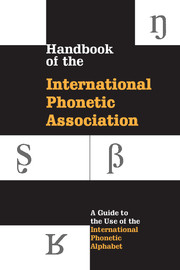 Handbook of the International Phonetic Association
Handbook of the International Phonetic Association Published online by Cambridge University Press: 06 November 2023
This section on extended IPA symbols was prepared by the Executive Committee of the International Clinical Phonetics and Linguistics Association (ICPLA), which can be contacted through the Secretary of the ICPLA, Wolfram Ziegler, Städt. Krankenhaus München-Bogenhausen, EKN, Dachauer Str. 164, D-80992 München, Germany. The original text and chart first appeared as an article in the Journal of the International Phonetic Association 24, 95–8 (1994), entitled ‘The ExtlPA Chart’, by the ICPLA Executive Committee. The list of IPA Numbers for ExtlPA symbols which has been added here appeared originally in an article by Martin J. Ball entitled ‘Computer coding of the IPA: Extensions to the IPA’ in the Journal of the International Phonetic Association 21,36–41(1991).
1 Introduction
At the 1989 Kiel Convention of the IPA, a sub-group was established to draw up recommendations for the transcription of disordered speech. The report produced at the Convention appeared in print in Duckworth, Allen, Hardcastle, and Ball (1990), being mainly a list of symbols, termed ‘Extensions to the IPA’, or ‘ExtlPA’ for short. Examples of the use of the ExtlPA symbols are given in Ball (1991), Howard (1993) and Ball, Code, Rahilly and Hazlett (1994) among others, and Ball (1993) includes them at textbook level. Various changes and additions to the original set of symbols are reported in Bernhardt and Ball (1993). The changes meant, however, that there was a need for a listing of the current set of symbols, preferably in as concise a form as possible. There was also felt to be a need for the symbol set to receive overt recognition from a relevant society, therefore the 1994 publication in JIPA marked the official adoption of the ExtlPA symbols by the International Clinical Phonetics and Linguistics Association (ICPLA).
2 The Chart
The chart included here is clearly based on the current format of the IPA Chart to make it directly comparable and equally user-friendly. There are, however, a few comments that will aid in the use of the chart. First, shaded squares on the main chart represent – as in the IPA Chart – articulations that are deemed impossible to make. Blank squares stand for sounds for which the IPA already provides symbols, or for sounds that are possible to make but for which no symbols are available. Clearly, this difference is straightforward to resolve with access to both charts.
To save this book to your Kindle, first ensure [email protected] is added to your Approved Personal Document E-mail List under your Personal Document Settings on the Manage Your Content and Devices page of your Amazon account. Then enter the ‘name’ part of your Kindle email address below. Find out more about saving to your Kindle.
Note you can select to save to either the @free.kindle.com or @kindle.com variations. ‘@free.kindle.com’ emails are free but can only be saved to your device when it is connected to wi-fi. ‘@kindle.com’ emails can be delivered even when you are not connected to wi-fi, but note that service fees apply.
Find out more about the Kindle Personal Document Service.
To save content items to your account, please confirm that you agree to abide by our usage policies. If this is the first time you use this feature, you will be asked to authorise Cambridge Core to connect with your account. Find out more about saving content to Dropbox.
To save content items to your account, please confirm that you agree to abide by our usage policies. If this is the first time you use this feature, you will be asked to authorise Cambridge Core to connect with your account. Find out more about saving content to Google Drive.